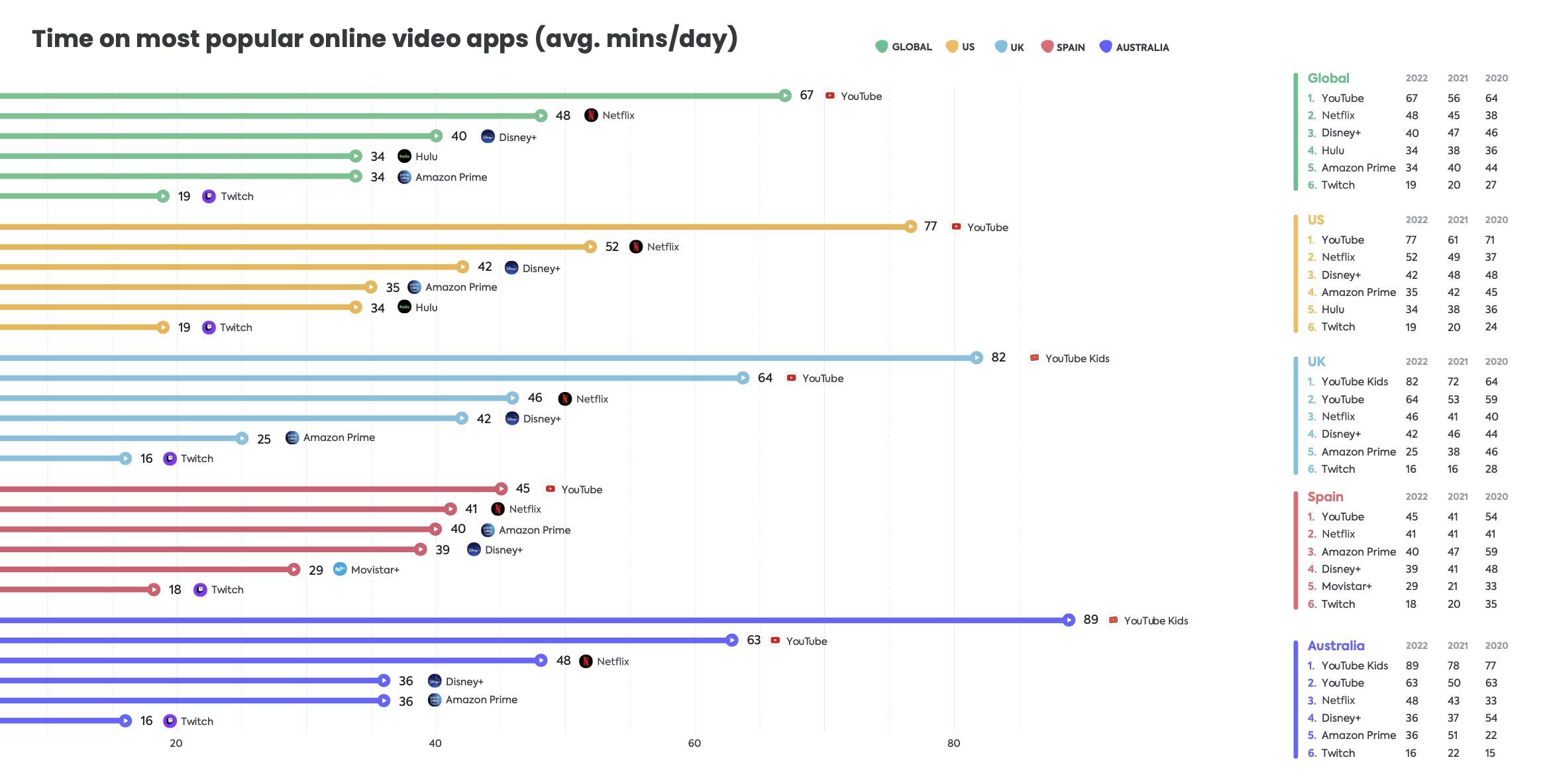
For another year in a row, TikTok has found itself as the social app kids and teens are spending the most time using throughout the day, even outpacing YouTube. According to an ongoing annual review of kids’ and teens’ app usage and behavior globally, the younger demographic — minors ranging in ages from 4 through 18 — began to watch more TikTok than YouTube on an average daily basis starting in June 2020, and TikTok’s numbers have continued to grow ever since.
In June 2020, TikTok overtook YouTube for the first time, with kids watching an average of 82 minutes per day on TikTok versus an average of 75 minutes per day on YouTube, according to new data from parental control software maker Qustodio.
This past year, the gulf between the two widened, it said, as kids in 2022 saw their average daily use of TikTok climb to a whopping 107 minutes, or 60% longer than the time they spent watching video content on YouTube (67 minutes).
TikTok not only topped the average daily usage of other video apps, like Netflix (48 mins.) and Disney+ (40 mins.), it also came out ahead of other social apps, including Snapchat (72 mins.), Instagram (45 mins.), Facebook (20 mins.), Pinterest (16 mins.) and Twitter (10 mins.) among the under-18 crowd.

Image Credits: Qustodio
Meanwhile, as the U.S. grapples with TikTok bans across college campuses and in the government, the app’s addictive video content was viewed, on average, 113 minutes per day in this market, compared with 77 minutes per day on YouTube, 52 minutes for Netflix, 90 minutes on Snapchat and 20 minutes on Pinterest.
There is still some good news for YouTube, though. The study found that the average daily time spent on YouTube was up by 20% year-over-year, to reach 67 minutes — the highest number since Qustodio began reporting on annual trends in 2019. YouTube also gained sizable global market share and mindshare last year, as 63% of kids worldwide were using the service in 2022. The report additionally broke down a few top markets in more detail, noting that 60% of U.S. kids watch YouTube, compared with 67% in the U.K., 73% in Spain and 58% in Australia. The second most popular video service was Netflix, with 39% popularity among kids worldwide.
Overall, kids under 18 managed to increase their video content viewing by 18% in 2022, watching 45 minutes daily, on average, across long-form video services like YouTube, Netflix, Disney+, Prime Videos and others.
Other winners for the year included Netflix and Amazon Prime Video, which saw 7% and 10% gains in popularity, respectively — meaning if they were used at some point by these under-18s. But in terms of average daily minutes spent, Prime Video dropped 15% year-over-year to 34 minutes. Disney+ declined by the same percentage, dropping from a 47-minute average daily to 40 minutes in 2022. Twitch also suffered last year with only 11% of under-18-year-olds tuning in compared with 16% in 2021.

Image Credits: Qustodio
TikTok’s growth among the younger demographic has forced Big Tech giants to combat the threat with short-form video of their own. YouTube Shorts is YouTube’s solution to the problem. Google this month reported Shorts crossed 50 billion daily views. Instagram, of course, has been cramming Reels into its experience — and receiving some backlash over the changes. Instagram head Adam Mosseri even admitted earlier this year that the platform has been pushing “too many videos” on users.
It’s not clear this shoehorning of Reels into Instagram has paid off with the younger crowd. In Qustodio’s analysis, the app fell out of the top-five most popular social media apps in the U.S., U.K. and Australia with users under 18. It still ranked No. 5 globally, however, behind TikTok, Facebook (38% of kids used it globally!), Snapchat and Pinterest.
Though the software firm chose to analyze Roblox among other video games, it’s worth also noting the game is a social network of sorts — and an extremely popular destination among kids worldwide. The gaming platform was popular with 59% of kids globally, and average daily time spent grew 4% year-over-year to 180 minutes. That’s larger than any other games, including the No. 2 game, Minecraft (up 37% to 48 mins.), Clash Royale, Brawl Stars, Clash of Clans and What Would You Choose?

Image Credits: Qustodio
Qustodio’s full report digs into other app trends as well, including Twitter’s 7% growth in popularity worldwide, which also led to it appearing in the list of most-blocked apps by parents in 2022 for the first time. It also delved into educational app usage where Google Classroom ruled on school devices, and Duolingo remained a top app on personal devices. And it looked at communication, where WhatsApp and Discord edged out Messages as the most popular way to chat with friends, though Zoom saw more minutes spent daily.
While the report’s data is limited to the app usage Qustodio tracks on its own platform, it’s a sizable group that includes over 400,000 global families with children in the Gen Z and/or Gen Alpha demographic. It additionally sureveyed 1,617 parents directly to ask them about how they manage their children’s access to technology.
https://techcrunch.com/
LastPass’ parent company GoTo — formerly LogMeIn — has confirmed that cybercriminals stole customers’ encrypted backups during a recent breach of its systems. The breach was first confirmed by LastPass on November 30. At the time, LastPass chief executive Karim Toubba said an “unauthorized party” had gained access to some customers’ information stored in a third-party cloud service shared […]
U.S. nonprofit healthcare giant Maternal & Family Health Services has confirmed hackers accessed sensitive patient, financial and medical information months earlier. In an advisory published on its website on Thursday, MFHS said a “sophisticated ransomware incident” exposed the sensitive information of current and former patients, employees and vendors. This information included names, addresses, dates of birth, Social Security numbers, […]
The Housing Authority of the City of Los Angeles, or HACLA, has confirmed it is investigating a cybersecurity incident shortly after the LockBit ransomware gang claimed responsibility for a cyberattack on the agency. HACLA, which provides affordable housing to more than 19,000 low-income families across Los Angeles, was added to LockBit’s dark web leak site on […]
Leave a Reply